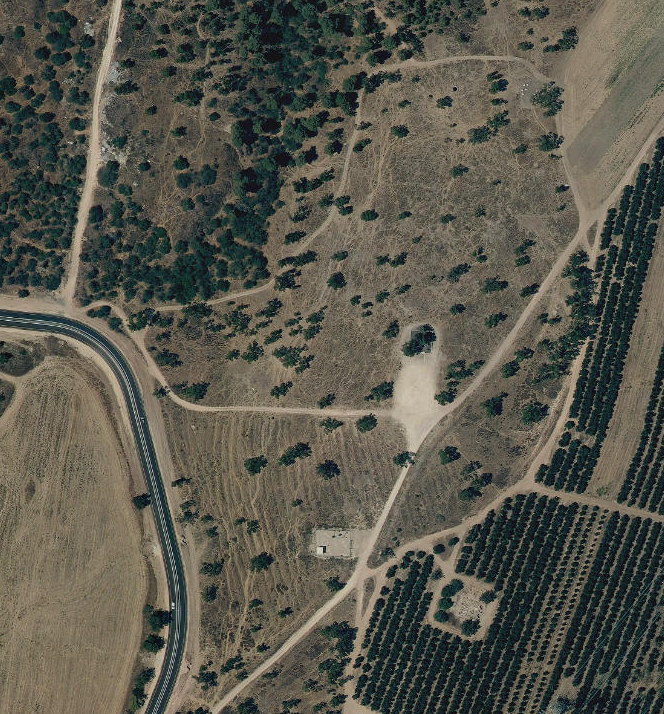Giv'at Arnon near Givati Junction
| Transliterated Name | Source | Name |
|---|---|---|
| Giv'at Arnon | Hebrew | |
| Khirbat ‘Ajjis er-Ra | Arabic | |
| Givati Junction | Hebrish |
- Fig. 1 - Location map from
Shmueli (2013)

 Fig. 1
Fig. 1
Location map
Shmueli (2013)
- Fig. 2 - Plans and Sections
from Shmueli (2013)

 Fig. 2
Fig. 2
Plans and Sections
Shmueli (2013)
- Fig. 2 - Plans and Sections
from Shmueli (2013)

 Fig. 2
Fig. 2
Plans and Sections
Shmueli (2013)
- from Shmueli (2013)
| Stratum | Period | Centuries CE | Description |
|---|---|---|---|
| III | Byzantine | 5th-6th |
Stratum III
Part of a rectangular building (5.5×12.0 m) and an adjacent installation were exposed. The northern wall (W13, W14; length 8 m, width 0.9 m) was built of medium-size
kurkar stones (0.10×0.30×0.45 m) set on a bed of small fieldstones (0.1×0.1×0.1 m); to its east only the foundation trench (L128) was preserved. Another wall (W17),
only partly exposed, implies that the building had a northern wing that extended beyond the excavated area. The building was delimited on the east by a wall
(W7; length 5 m, width 0.65 m; Fig. 3) built of roughly hewn medium-size kurkar stones (0.20×0.25×0.25 m), preserved three courses high. Wall 16, bounded with W7
and perpendicular to it (see Fig. 3), may indicate that the building had another wing that extended eastward. The western wall (W8; exposed length 1.35 m, width 0.7 m)
was constructed of medium-size kurkar stones (0.20×0.25×0.25 m). Another wall (W9; exposed length 1.9 m), built of medium-size kurkar stones (0.2×0.3×0.6 m),
ran through the center of the building; its function is unclear. The floor of the building (L109, L119) was made of tamped light brown earth, into which three
Gaza jars were set upside down (Fig. 4). The jars’ bases are missing, and one of their sides was deliberately broken so that the vessel could fit along the
northern section of W7. The broken jars were probably used as storage installations. A fourth jar, set up right into the floor, had also been
intentionally broken; its broken part was placed beside a fieldstone that lay on the floor. |
| II | Early Islamic | 9th-10th |
Stratum II
Parts of buildings and a courtyard from this stratum were found in several places in the excavation area. A square room,
only partially exposed, was built over the installation: two parallel walls (W3, W10; exposed length 2 m, width 0.55 m)
built of medium-size kurkar stones (0.20×0.24×0.25 m), that abut W12, which was now utilized in secondary use as a wall of
the building. The room was paved (L114, L123) with small kurkar slabs (0.1×0.1×0.1 m) and tamped light brown soil set on a
bedding of soil and stones of different sizes. |
| I | Mamluk | 14th-15th |
Stratum I
Remains of this layer were only found in Square I11: a circular cooking oven (L124; diameter 1 m, depth 0.55 m; Fig. 12) that was dug into the
natural soil of the hill and penetrated the floor of Stratum III. The oven’s walls were made of fired clay; its floor was made of medium
size fieldstones (0.3×0.3×0.3 m) and it was found filled with ash. |
- Fig. 2 - Plans and Sections
from Shmueli (2013)

 Fig. 2
Fig. 2
Plans and Sections
Shmueli (2013) - Fig. 4 - Upside down and broken jars
from Shmueli (2013)

 Fig.4
Fig.4
Jars set on the floor of the building, looking east
Shmueli (2013)
| Effect | Location | Image | Description |
|---|---|---|---|
| Broken Jars in Fallen Position | Stratum III in a rectangular building (L109, L119)
 Fig. 2
Fig. 2Plans and Sections JW:
|

 Fig.4
Fig.4Jars set on the floor of the building, looking east Shmueli (2013) |
Shmueli (2013) excavated Stratum III in a rectangular building (L109, L119) at Giv'ti Junction in 2011 where, on the floor, they found three Gaza jars which were set upside down (Fig. 4) and broken. A fourth jar was found upright but also broken. |
- Modified by JW from Fig. 2 of Shmueli (2013)
 Deformation Map
Deformation MapModified by JW from Fig. 2 of Shmueli (2013)
-
Earthquake Archeological Effects chart
of Rodríguez-Pascua et al (2013: 221-224)

 Earthquake Archeological Effects (EAE)
Earthquake Archeological Effects (EAE)
Rodríguez-Pascua et al (2013: 221-224)
| Effect | Location | Image | Description | Intensity |
|---|---|---|---|---|
| Broken Jars in Fallen Position | Stratum III in a rectangular building (L109, L119)
 Fig. 2
Fig. 2Plans and Sections JW:
|

 Fig.4
Fig.4Jars set on the floor of the building, looking east Shmueli (2013) |
Shmueli (2013) excavated Stratum III in a rectangular building (L109, L119) at Giv'ti Junction in 2011 where, on the floor, they found three Gaza jars which were set upside down (Fig. 4) and broken. A fourth jar was found upright but also broken. | VII+ |
Baumgarten, Y. (2001). "A Pottery Kiln near the Giv'ati Junction." 'Atiqot 42: 323-324.
Langgut, D., Eli Yannai, Itamar Taxel, Amotz Agnon & Shmuel Marco (2016) Resolving a historical earthquake date at Tel Yavneh (central Israel) using pollen seasonality, Palynology, 40:2, 145-159
Schmueli, O. (2013). "Giv‘ati Junction." Hadashot Arkheologiyot 125.

